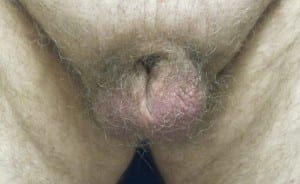Buried penis syndrome
Posted May 15, 2015 in Services for Men by Josef Hadeed, MD
The buried penis syndrome in men is an unusual condition that is difficult to manage. This condition is also known as a trapped, hidden, inconspicuous, or concealed penis, and affected men often experience physical symptoms and emotional distress. Contrary to popular thought, the actual length of the penis is normal but it is hidden entirely beneath the lower abdominal pubic fat pad. The buried penis can be either congenital or acquired. In congenital cases, bands of tissue connect the scrotum to the shaft of the penis, causing the penis to retract within the suprapubic fat. For the acquired buried penis, one of the more common causes is aggressive circumcision, in which the suture line constricts during healing, forming scar tissue. This scar tissue traps the penis and pushes it into the suprapubic fat pad.
For most acquired cases, however, obesity is a main contributing factor in the development of the buried penis. The lower abdomen and suprapubic fat pad is an area of preferential weight gain in men. As the amount of fat in these areas increase, penile length is lost as the penis retracts into the fat pad. As the fat envelops the penis, a moist environment develops which leads to bacterial and fungal growth. A cycle of infection, skin breakdown, inflammation, and scar formation occurs, further perpetuating the problem. Men affected with a buried penis may experience recurring urinary tract infections, difficulties with voiding, poor genital hygiene, erectile dysfunction, and pain with erections.
weight gain in men. As the amount of fat in these areas increase, penile length is lost as the penis retracts into the fat pad. As the fat envelops the penis, a moist environment develops which leads to bacterial and fungal growth. A cycle of infection, skin breakdown, inflammation, and scar formation occurs, further perpetuating the problem. Men affected with a buried penis may experience recurring urinary tract infections, difficulties with voiding, poor genital hygiene, erectile dysfunction, and pain with erections.
There are many options for surgical reconstruction and the technique chosen must be individualized to the patient presenting for repair. Factors that determine the optimal reconstruction for the buried penis include the underlying cause of the disorder, the quality and amount of healthy penile skin, the presence or absence of a prior circumcision, and the presence of other medical conditions such as diabetes mellitus. Men who are obese or who have undergone previous gastric bypass may require a panniculectomy, or removal of the excess lower abdominal tissue. Direct excision of the suprapubic fat in the mons area is often required. Liposuction can be considered as an adjunctive procedure to address residual areas of fat protrusion in the upper scrotum or pubic area. After the fat is excised from the pubic area, tacking sutures are placed internally to suspend the pubic area in an upward position and prevent the penis from retracting into the pubis. Finally, the quality of the skin of the penile shaft must be evaluated. If the skin is scarred, it must be resected and replaced with either a skin graft or a skin flap.
Men with a buried penis may suffer from self-esteem issues relating to their genitalia. Additionally, they may experience symptoms affecting their quality of life and interpersonal relations. Often, they have genital discomfort related to the cycle of inflammation and infection. A well thought out and customized treatment plan for each individual, although challenging, can be successful in restoring sexual function and eliminating voiding discomfort. A return of improved self-image and quality of life follows.

